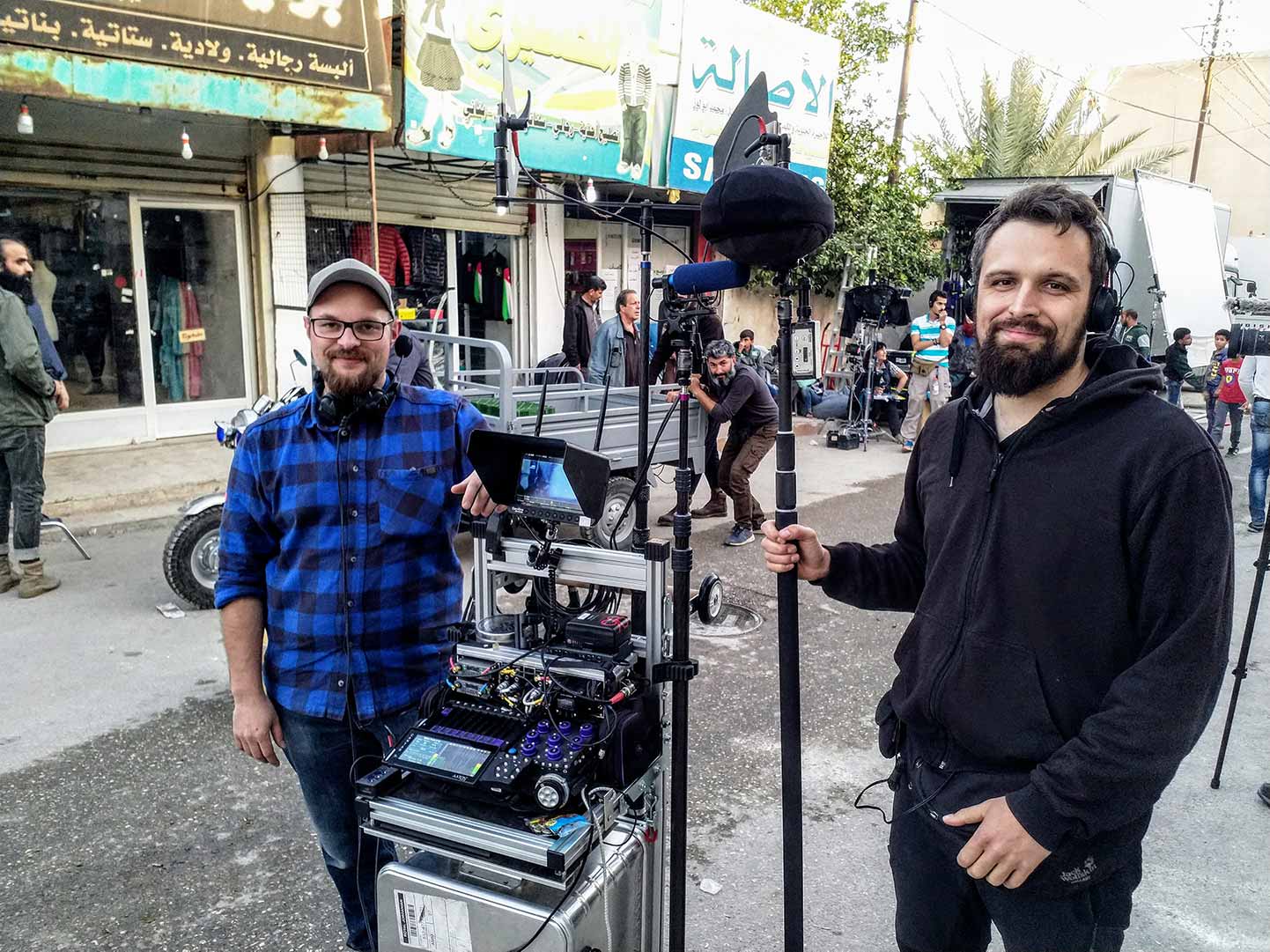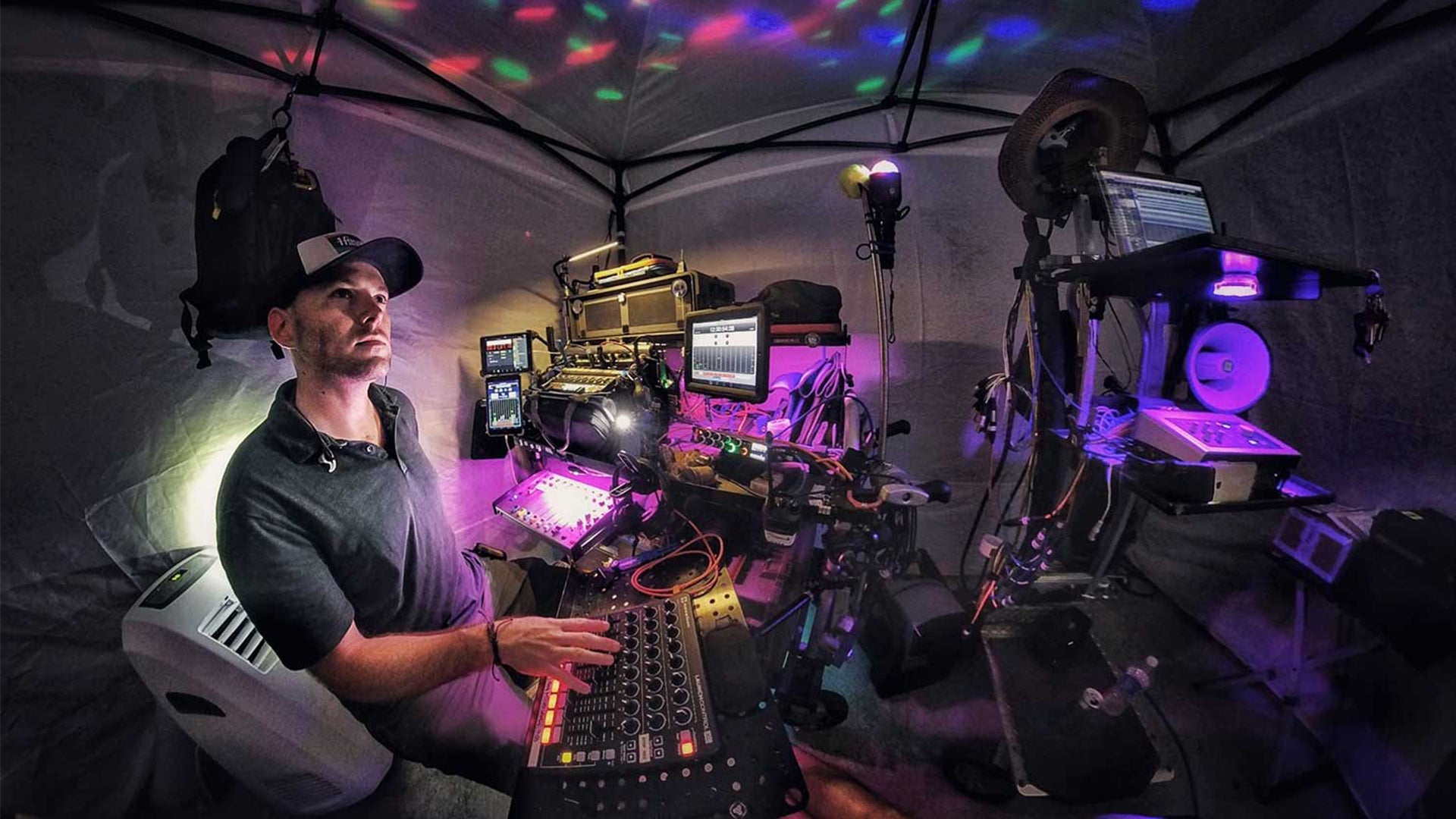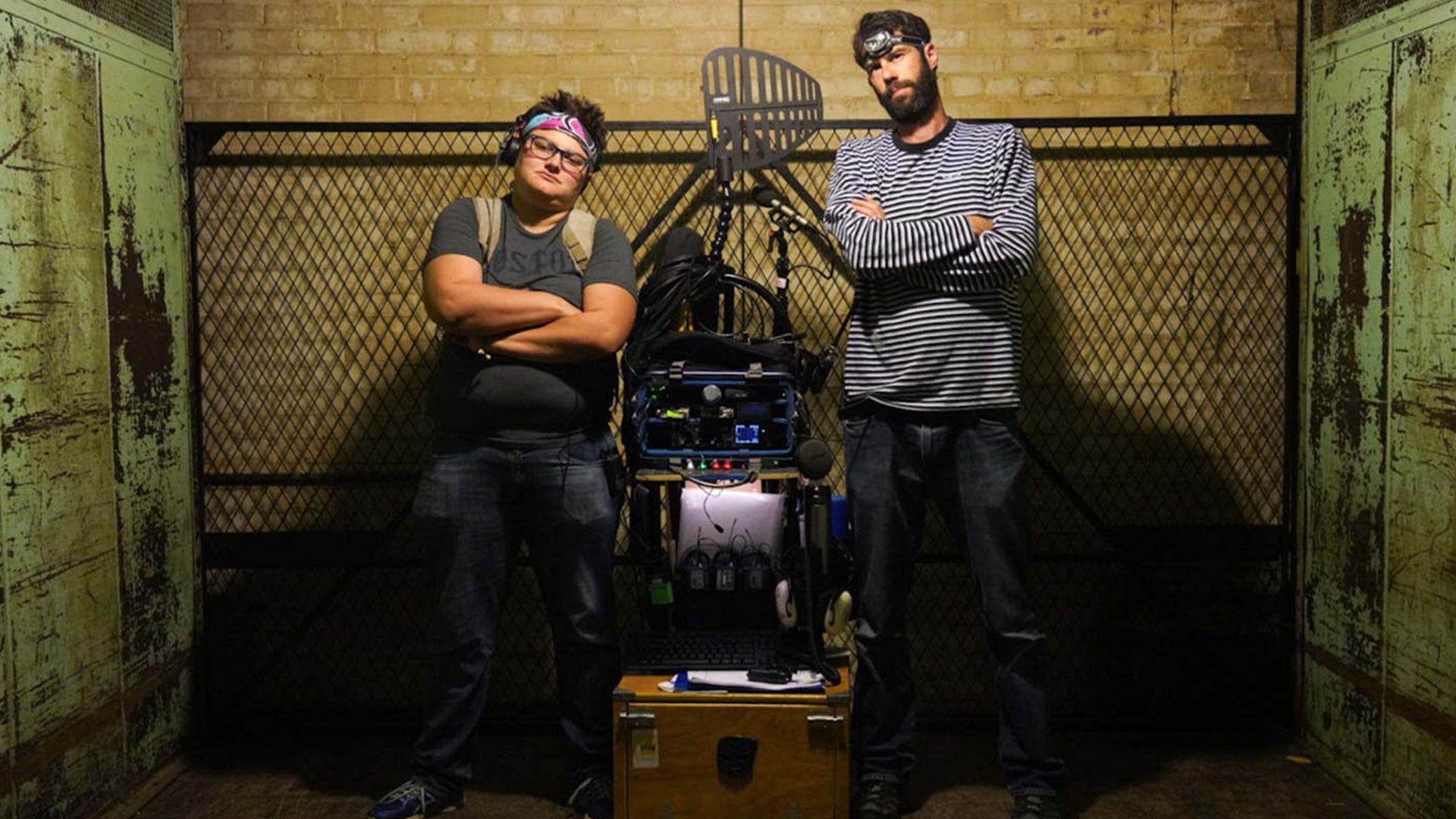
Tim Stephan hails from Hamburg, Germany. A Filmtonmeister for over 10 years, both in Europe and abroad, we jumped at the opportunity to talk with him and find out more about his experience, ideas and advice for working in the film and commercial sound industry.
Find out more about, or get in contact with Tim via his website at timstephan.de
Read our interview with Tim below, who, at the time of writing, is finishing up on a film production in Jordan.
Are you working on anything exciting at the moment?
Right now, I'm working on a feature film with my boom op and friend Pirmin Punke in Jordan until the mid of December, followed by a week of shooting in Portugal in January. Everything is going smooth so far and it's a joy working with a fantastic crew of French, German, but mostly Jordanian people. I'm really happy to do this production and I think it's one of the really big advantages of our job to get to know people and places around the world by just working with them or there.
You’ve been involved in a range of productions including TV series, documentaries and feature films. That kind of versatility must come with lots of challenges…
I like to be involved in different projects and wrap my head around their very specific requirements. If I didn’t, I would probably have stuck to civil engineering and a 9 to 5 job. So generally, I would be happy to join projects that challenge me and my equipment. I like to face new situations, solve problems, learn and become an even better prepared and more confident member of the crew for the next project. Features will often allow you to use your full equipment and require you to be prepared for anything and everything. It’s the planning in advance and the opportunity to use a bigger, broader range of equipment and fallback options that makes it fun. Whereas in documentary productions you will have to make choices in advance, down to the very last detail. That can be a challenge in itself.
"I like to face new situations, solve problems, learn and become an even better prepared and more confident member of the crew for the next project.”
For example, how to scale down your equipment to a portable kit while still matching the situations and also weather conditions you would find yourself in. Knowing your equipment inside out and also the parameters of its performance is vital. Especially when you’re on a doc production in a country you have never visited before; so different to your home turf. Recently we filmed a nature doc in the jungle of Thailand. I faced a lot of stress on various levels: traveling and moving in the jungle was physically exhausting, not finding the content that we expected raised the level of emotional stress in the team, and then there was the weather - humidity in particular - adding another factor. From past experiences I knew how durable my equipment was, but filming in monsoon season was kind of scary. Nothing failed in the first few days and knowing I could rely on the technology took a big burden off my shoulders. The experience I gained then helped to keep calm in projects after that, too.
Another interesting challenge was the web-series, “Klicknapped”. This production had completely different demands: The whole story is based on a couple that is kidnapped and locked-up in a recording studio. Understandably, the recorded sound, often the dialogue, had to sound believably clean and dry. The main challenge was that the set was built in a big, echoing industrial hall with large windows facing a cobblestone road. I had to come up with an idea on how to alter the reverb and reduce the sound of the trucks driving by within four days, in a way that would allow sound recording that would believingly match the story. I ended up filling the big windows with 20 cubic meters of rockwool, putting two layers of thick stage Molleton as ceiling over the set construction and used a Schoeps Super CMIT to help reduce the reverb as much as possible. Afterwards I heard that the sound engineer who handled the files in post didn't even notice that it wasn’t shot in a recording studio. So, I think it kind of worked.

Production Sound Mixer Tim Stephan and Boom Operator Pirmin Punke on set.
Are there any items in your kit bag that you can’t live without?
I love my Sennheiser MKH50s and I bring them to every project. But I think the most useful pieces of gear I own, are those which made my life as a production sound mixer so much easier in ways of protecting my health or taking stress off me. These are for example my harness, when it's a bag job. Or my Sennheiser HD26 headphones with its built-in limiter. But also all kind of wind protection for boom and lavalier mics.
Because of the lessons I had to learn on my first production, I'm kind of obsessed with avoiding even the slightest rumble of wind on any of my microphones. For me this is always a destruction of the illusion, which we as filmmakers trying to build up for the audience. The distortion of a microphone membrane is not the story I want to tell with my work. And then there are all those little things and gimmicks we carry around as sound mixers: All kinds of tapes; transmitter straps, especially ankle straps; concealers and foamies etc.
How do you handle difficult weather conditions like wind and rain?
"Normally I place them a little bit further inside the costume than I would with no wind, just to use the costume itself as wind protection. But if that doesn't help, I would grab a Piece-A-Fur."
I think wind and rain are weather conditions quite well known to us mid-European sound mixers. Lavalier mics are sometimes difficult to hide if you are forced to protect them against heavy wind. Normally I place them a little bit further inside the costume than I would with no wind, just to use the costume itself as wind protection. But if that doesn't help, I would grab a Piece-A-Fur. If I face thin costumes like t-shirts, I would cut out a bigger piece of fur and cut it down on the edges to smooth it out, just to avoid this small bump on the cloth you get, when you just tape a Windbubble under clothing.
Fur, by the way, is also a fantastic solution for hairy chest or rustling costumes. When you are wiring for example a shirt you can tape a piece of fur behind the capsule with the hair facing the body or the underwear. This way it will lift the shirt a little bit from the layer or chest hair underneath, while the fur is also reducing the friction between the layers and thereby the rustling In light rain I would just put on the fur on my Cinela to damp the drops hitting the windshield and put it in a dry spot between takes. Of course, you have to dry it accordingly after wrap. In heavier rain I use a raincover. What I find rather demanding is high humidity. Traveling in high humidity and rainy areas can be tricky when chances are high you might not find a dry place for several days.
When working in Thailand during monsoon season, I took a big airtight bag with two big packs of dry pallets in it to Thailand. Each evening I would carefully blow dry the fur of my windshield and put all my equipment into the bag to get rid of the moistness. The last thing you want to have is corrosion inside your gear or new ‘lifeforms’ growing on your microphone's membrane.

Tim in the Jungle, fighting the elements in Thailand
Tell us a bit more about yourself and how you embarked on your sound career.
Actually, my career is built on a lot of happy coincidences. Neither is my family background connected to film or any creative field nor was I a kid blessed with musicality. At first, I studied civil engineering, but after a few semesters I got pretty frustrated and couldn’t imagine myself in an office job or on a construction side. I went to a career counselling session and the guide there asked me what the last non-study-related activity was that I had enjoyed. Actually, I kind of bluffed a bit. I remembered how my pretty cool music friends had held jam sessions in our student apartments and by accident I had recorded one and found it pretty fun. I told my counsellor that I enjoyed recording, so she sent me to the SAE Institute and I started to study audio production. Sooner or later I realised that my career as a studio sound engineer who only knows four chords on the guitar might be a short one. Luckily, I found an internship at an ADR studio.
It just so happened that these guys were also producing a kids tv show in Mallorca. For some reason they didn't have a sound recordist on the pilot and the sound was - no wonder - horrible. True to the motto “better a sound newbie than no sound guy”, they sent me, who had never done a live recording on set before. I remember how I read the user manual to the Wendt mixer on the plane. At that point I had only an idea what a field mixer even looked like. I arrived on set and received a box with the equipment, put everything together and somehow got sound out of it. Day one was a disaster. It was windy and the only thing I had was a foamie for the boom mic. The only thing I could hear in the recording was the harsh sound of wind. Thanks to google I found out about this weird, useful tool called windshield... I asked my boss back in Germany to buy one at a music store and send it via overnight to Mallorca.
Set recordings are expected to be as clear and direct as ADR, which sets the bar high for us sound recordists on set.
Installing it the next day was kind of an epiphany. If this wasn’t enough, I had taxi radio and babyphones on the radio microphones. Looking back, it was a disastrous, yet funny situation and it could have been my one and only. But each evening the crew sat together at the pool and I had the chance to get to know two very experienced camera operators from Hamburg and they told me about their experiences and about film making and I thought, "this sounds like something I could really enjoy doing". At uni word spread that I had... well... "experienced" production sound and I more and more got inquiries for student films and projects. I accepted nearly every project. Looking back now, I would say that the first two years are the foundation of my career now. It’s a snowball principle.
What’s it like to be a production sound mixer in Hamburg/Germany?
Due to the history of film making and how media generally developed in Germany, most of foreign films are dubbed when entering the German cinemas or TVs. And even though you would assume that the audience is used to the sound of ADR and might easily accept films with a high ADR ratio, they’re not. Actually, it has flipped some great expectations onto German production sound mixers. Set recordings are expected to be as clear and direct as ADR, which sets the bar high for us sound recordists on set.
On top of that, directors and actors in Germany want to avoid studio recordings as much as possible, to preserve the energy of the performance on set. To meet these high expectations is not only a challenge, but also the fun part, of working as a sound mixer in Germany. I am lucky to have Hamburg as my base – not only is it my hometown, in which I grew up and am well connected, but also it is one of the few cities in which nearly every genre of film-production can be found. From commercials to features. Also, it’s great to have such a supporting and well-equipped sound rental store like Zeigermann_Audio nearby.
As someone who’s been working in professional audio for just under a decade, what advice would you give to people just starting out in the industry?
I guess there are different ways in getting your career started. I obviously chose a path of trial and tribulation. Which also means you have to be persistent and endure the ups and downs. It’s not the fastest way, but also not a bad one. I would hope that I built something that is reliable and solid for many years to come. A faster way might be to start with a professional internship right away. Get in touch with a senior sound mixer, work as an intern, utility, or second boom op on various projects and help out at film student sets.
Learn from the experienced ones and apply to sets with people who are starting their careers, just as you are. In the end, no one will ask for a diploma but want to know what projects you have been involved in, so building your resume is important. And no matter what way you choose, connecting with film makers, joining as many crews and projects as possible and never resting are the key factors. Don’t rest on your laurels.
Challenge yourself. Gain trust in yourself and your equipment. Grow together with other departments and, most importantly, don’t be a douchebag on the way! ;)



